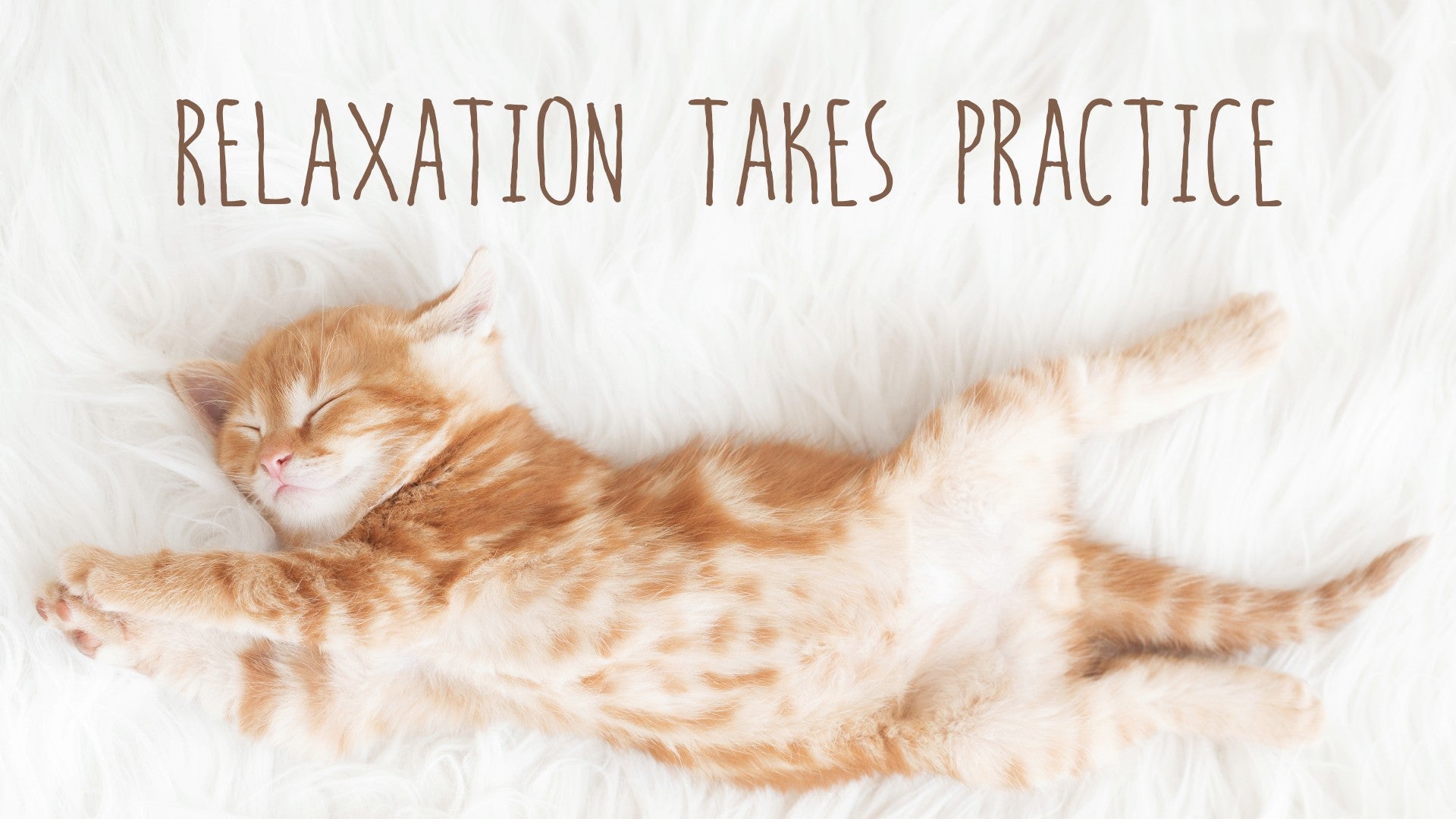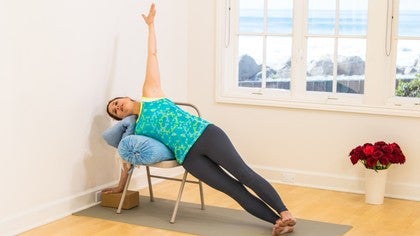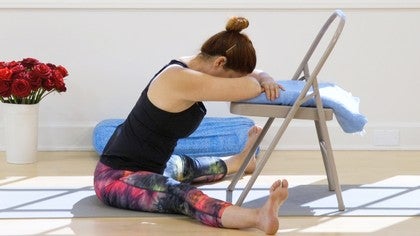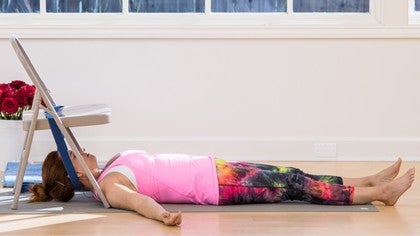Description
About This Video
Transcript
Read Full Transcript
(waves crashing calmly) Hi everyone, welcome to Yoga Anytime. If you took the inversion and back bend active restorative yoga practice with me, this is another active restorative practice but it focuses all on standing poses. I love it, I am really excited to share it with you. We're starting in one neutral position, which is the child's pose, it's obviously not standing but it's a good way to get some length. You'll need several props for this session.
You'll need two chairs, one yoga mat, one black, two bolsters, and one blanket. Let's get started. I have my mat with the short edge right up against the wall. I have the chair pressed up against the wall with the seat of the chair facing toward me, and then one bolster, you can also use folded blankets, that's okay too. One bolster, right across the front of the chair.
I'm gonna lean back, kneel. Feel free to broaden your knees as much as you want, I like to keep my mine about hip distance apart. I come in close enough, like I said earlier, the idea is to create lots of traction. So once I get close enough to slide my arms forward, and bring my forehead on the lip of the bolster, then I can kinda scooch back a little bit to create that traction, that dynamic tension. So I'm gonna hold onto the back of the chair with my hands, thumbs on the top side, fingers wrapped around.
Start to work my hips back a little bit until I feel that traction I'm looking for. And your forehead, if you could rest it so that right where the top of the forehead meets the scalp, that's about the right place. And then start to sink the top of the thighs all the way into gravity. Sink the weight of the pelvis. And can you find the place where you still have enough traction but you're not getting pulled off away from the chair or off away from the hips.
Off away from your heel bones. Just kinda wiggle your way into that place. We're gonna start with one full minute with our arms stretched out like this, so you're like in an extended child's pose and then we'll follow with another minute with the elbows folded, so let's start now with this full minute. Start to move your awareness into your breath. Getting all the segments of the spine to lengthen.
And remembering that as you're here in this active restorative practice that you have just enough tension that you're holding to keep the alignment. Cause you're not using as many props as you would if you were doing just strictly restorative. But then you're balancing out this level of relaxation. So that there's this wonderful story or relationship that's developing between the little bit of tension that you have and the relaxation that you're allowing to occur. So let's take one more inhale and exhale with these arms out.
And then we'll release the arms, fold the arms, just rest one on top of the other. You can kind of cup your elbows with your hands. If you feel as though your head is dropping too low then just rest your head on top of the forearm instead. And remember the idea is not to sink through the shoulder it's to sink through the pelvis. We'll finish up about these 30, 35 seconds here.
Go ahead and take one more inhale and exhale. We're gonna remove the bolster, bring it to the side, and just lengthen the arms out without the support of the bolster. So inhale, lift your head up, release your arms. Just place that bolster to the side now. Let's see if we can go a little deeper here, by stretching the arms forward, holding onto that backrest of the chair, letting your forehead rest right on the lip and walking the hands as high as you can.
You can also pad the chair if you feel as though you need a little bit more support. We'll be here for about 30 seconds, go for the most amount of length that you can without sinking your weight into the shoulders. Listen to that breath that you're taking now. And follow it with two more breaths. And then when you complete that second exhalation, just slide the hands down toward the front edge of the chair push the arms to straight, come sit upright.
Let your hands rest on top of your thighs and just close the eyes, we're gonna pause here. Before we set up for the next pose. So besides the traction that that pose offers it also gives an opportunity to open the shoulders. We're gonna open the eyes and head to the next pose. So we're gonna head to the vasisthasana now, and this is a wonderful variation for anybody that feels a little wonky in that pose.
We use a bolster and we use a chair, and we may or may not use a block and a blanket but we're gonna bring it over just to see how it fits. I'm gonna first just take the bolster to the side. Stand up, and I'm gonna move this chair so that the side of the chair is facing me. Then I'm gonna take the bolster, place it back on the seat of the chair, but I'm gonna slide the short end right through it. I'm gonna grab that block and the blanket.
And just have it to the side. In front, right in front of that chair. I'm gonna start on the lowest end. Again, we may or may not use it. The way to tell if you need it or not is pretty much your height and the ability to take your torso over the bolster.
How we get into this is really easy. I'm just gonna lean my weight on the bolster. And step my feet together and then I'm gonna take the right waist, bring it right to that bolster. Then I'm gonna slide my hand out on top of that block whether I use it or not. You can see for me it's probably, maybe okay, let's check it out.
And then I bring my feet together. And then I'm gonna bring my tailbone slightly forward and stand really tall on that bottom arm. Let's go ahead actually and grab the blanket now and see if it's gonna be the right support for my head. Ah yes, that feels very good. And then I rest the free arm on the top hip.
If you wanna be in the classical pose, just stretch that top arm straight up toward the ceiling. I let the weight of my torso rest on the support. I let the weight of my head rest on the blanket. The tension, very little, is the firming of the legs, the firming of the arms. But the weight of the body continues to rest on the chair, the bolster, and also the head.
Such support that you can actually close the eyes. Breathe, feel your way into what you're doing. Creating a steadiness in the lower body. Creating a firm standing arm. And a reach up through the top chest.
Let's stay for one more full minute. And as times goes on like all the other poses, you may determine to switch the props a little bit. It's okay, you can move in the pose, you don't have to be like a statue. I'm already feeling it, I'm gonna go ahead and actually remove this blanket. And I'm gonna remove the block.
Slide up a little bit more. Make that external rotation with my bottom arm. And take the top arm up again. And the goal is not necessarily to look up, but if you wanted to you could. Otherwise you could just look straight ahead.
Let's take two more breaths here. As you finish that exhalation, take your top hand and bring it right to the bolster. Go ahead and look down toward your bottom hand. Take the top leg, step it forward, push into that foot so that you can turn your torso toward the seat of the chair. You can drop one knee down to the floor, pick up the bottom arm, drop the other knee toward the floor.
And now you can be in a supported child's pose, it's very soft, just drop those hips back. Let your arms fold on the bolster and let that head drop down as well. Right now you should really feel the difference between the right side of the body and the left side of the body. It's a good feeling yeah, it's this feeling that you created some stability. But there's also an opening feeling at the same time so it's not just all brute force being in vasisthasana.
Also this feeling like god you're so connected to the right side of the body now. So let's switch it up. I'm just gonna slide this support over to the other end of the mat. Pick up the chair and bring it to the other end of the mat. And once again, prepare to go into the pose.
Put my hands on the bolster. Bring that under waste right up against it. Take the hand down. Bring those legs together. Find the right rotation with that bottom arm so that shoulder externally rotates like you would in a downward facing dog.
And I think for this one what I'm gonna do is just use the blanket so I'm gonna put it right between my shoulder and my head, whoops it may fall a little bit. I'm feeling like I have to hold it there, so if that's the case, forget about it. Cause you don't wanna have to feel like you're holding it, the prop should work in such a way where they really are holding you well and comfortable in the pose. Take that top arm, stretch it up. The beauty of this is the support that I have on my underside of the torso right now, on my left side, I don't feel like my head has to do a whole lot.
It finds the right place, you know. It's not about having to look up, turning all the way. It's just where's the right place, where do I feel like I've landed. Like a mm, there it is. Let's stay here for a full minute.
Last little bit, those legs still firm and that bottom arm still firm. So listen to that breath that you're on right now. Let it go. Stay just a little bit longer. Taking that top leg, and I'm just gonna stretch it forward through the heel bone a little bit.
Get a little bit more of a sideway stretch, especially if you know that you're kinda tight there. Let's finish it up with two more full breaths. With that exhalation, bend the top arm. Put it down on the bolster. Step the top leg out.
Roll your torso toward the bolster. Pick up the bottom arm, you can put it right on the bolster. Drop your knee. Drop your other knee. You're facing toward the bolster now.
Dropping your hips and releasing into this really supportive child's pose. Let your head go. Let your neck go. What a unique way to do that pose, right? Makes it really accessible to a lot of people who perhaps don't wanna try it, or maybe even a little thinking like they can't hold themselves in the pose, this really gives somebody an opportunity to experience it.
The next pose we're doing is pevita trikonasana, it's revolved triangle pose. Another kind of unique way to do it. All we need for that pose is just the chair and the blanket. So I'm gonna move this bolster out of the way. I'm going to move the block out of the way as well because we no longer need it.
I'm gonna take the blanket and fold it up. And bring it right on top of the chair. I'm turning the chair around. And this is your standard yoga chair, but you can use any chair that's at the house for this. Taking that blanket and just flipping it right on the back side of the chair.
And just because the wall is here but is not necessary, I'm gonna use the wall support. I'm gonna take my back foot, that's gonna be my left foot and bring it right to the wall. Step my right leg forward, that good three and half or so feet distance and I'm about hip distance as well. Place the support out in front of me. And then find myself as square as possible in the pelvis and start to come forward.
And then all I'm going to do to initiate the twist, press the palms on the front of the chair, and then slowly use it as leverage to turn my left ribs to the right and my right ribs to the right, and then rest my cheek, my left cheek, right on the blanket. The left arm goes loose and limp. It just relaxes right on the seat of the chair. The right arm either hangs down, or comes to the, or rests at the lower back, so you decide what you want. Let's, if it's possible for you, take the right arm back, we'll hold here for a minute and then we'll do the arm hanging for about 30 seconds or so.
Let that cheek be super heavy. So here's where the legs stay firm but the arms and head go loose and limp. Obviously it's not necessary to use the wall, but it does give you some feedback of that back foot. In order to engage those legs you can be in the feet a little bit more by pulling the tips of the toes back to the left heel bone on that left foot and then stretching the right heel bone forward toward the right toes. And this way you feel all the skin at the sole of the foot lengthening and stretching.
Can you do that and still keep the skin on the top of the foot really relaxed. There maybe a tendency to push through that left hand at the chair but can you just really let go, let that arm go loose and limp. So let's take one more inhale and exhale here. And then we're just gonna slide that back arm all the way down now, let it just hang. Just like a ripe piece of fruit off of a branch, just let it drop.
As I exhale, let that armpit fall toward the elbow, let the elbow fall toward the wrist. Let the wrist fall toward the fingertips. Go ahead and notice the breath that you're taking right now and follow it with two more breaths. When you finish that second breath, let your right hand come on the seat of the chair just across from your left hand, press through those palms, tuck your chin just a little bit and bring your forehead to the blanket. Pause.
Then bring your hands to the blanket on either side of the head, elbows in close. Inhale, straighten through the arms to lift the spine. Exhale, pause. And then bend through the front knee, and take your left foot to join your right foot. Close the eyes, and let's pause again.
God, it's really an interesting way to do this pose. I feel the rotation that happened. I'm hopeful that you do as well. And I feel the work in the legs that it takes to stay stable in that pose. All we're gonna do now is just switch.
Taking the right foot back. And bringing it to the wall. Straightening through those legs, getting some length at first. And then as you exhale, taking yourself toward that blanket, bringing the right arm down. Turning the head to the left to rest the right cheek.
And taking that left arm and bringing it back to the lower back and we'll be here for one full minute. When we do this pose, especially when that front hand, or the bottom hand, in this case the right hand, we use it a lot as leverage, we use it to push and to turn and in this case you don't need to push at all. You don't need to do anything to try to take you deeper into the pose, that's why the props are set up this way. Now you can walk this hand forward a little more, just let the elbow be loose, let it hang. And turn the head as much as you want.
It's sorta this new paradigm of like how can I be in a strong yoga pose and not push my way into the alignment. How can I create this new paradigm where the props comes to me enough so that I really just need to show up. I just need to show up. So we'll take one more full breath right here. And then let's that left arm come down, and just let it hang completely, let it just drape down.
If you find yourself pushing with that right hand at all, stop, just stop. And then notice the breath that you're taking right now, take two more. And then you'll bring your left hand across from your right hand so both of your hands are on the seat of the chair. Push the palms just a little bit to tuck the chin and bring your forehead back to the blanket. Then bring your hands on either side of the head.
Push through the arms so that they're straight and the spine comes away from the chair. Bend through the front knee, step your back leg foreword. Close the eyes, be upright. And pause. Just notice the feelings that are surfacing.
The steadiness that you created through your lower body. Hopefully the release around the neck and shoulders. We'll move onto the next pose which is uttanasana. All I'm gonna do is just turn this chair around. You could put a bolster on it if you needed a little bit more height.
I think this is a good set up for me. I'm gonna take the blanket and place it right across. Cushion the chair. Step away just a little bit cause I'm a little close. Think about exactly what you do if you do a classical uttanasana, steadiness through your legs, lengthen through the spine.
Coming forward at the hips. Bringing the elbows on the seat of the chair. Letting the forehead rest. Holding your arms and hands however you prefer. I'm just wiggling myself back a smidge more.
Keeping my weight steady through the feet and feel free to fold your arms. Feel free to interlace your fingers, whatever feels good. And this is the perfect release after the rotation. And what's beautiful about this is that your head gets the support, that's what we're doing. This is what makes this pose cooling to the nervous system is that the head, the weight of the head is actually rested on something.
Of course you want that length in the lower back, no rounding in the lower back so you should position the support on the chair that achieves that. You wanna feel that all those segments of the spine are getting an equal lengthening. Let's stay for another good 'bout a minute. Let's stay for about a minute and a half. If you need to come out before then then go ahead and do it.
When you exhale I just encourage you to let that weight of the head sink down. And if you decided that you needed more support, you might find that over the minute or so, you'll need less so maybe you just get rid of some of that support. But the head stays supported no matter what. Head and arms stay supported. If you need more length you can always push that chair forward a little bit.
But do try to keep your hips pretty much over those ankles. I'm not sure who you are in this pose in terms of your standing and your feet. But I tend to pronate quite a bit. So if you're like me, drive the little toes into the floor, and stretch them through all the toes until you land at the big toe mount. And reach and stretch through the big toe a little bit.
So that you feel your weight move from the outer heels, across the sole of the foot, and into the big toe. So go ahead and finish the breath you're on now. And take one more. And then just place your hands on either side of the head. Keep the chin down just a little bit.
Firm your legs and when you're ready on an inhale, straighten through the arms, just so that your torso lifts and just pause a second. Then bring your hands to your hips. When you're ready, inhale with strong legs and a flat spine, come all the way up. Release your arms and just pause, oh it makes your tadasana really good. Yeah because you're connected to your lower body but you're light and lifted in your upper body.
And all you had to do was just do it like that. So great. Really, just stay a little bit. I mean, I'm feeling it. Let's just stay and kinda ride this for just a little bit.
Okay, let's open the eyes. What I was saying before about arriving in a pose, it's not that I'm saying that you land it and you go, there it is, like there's no where else to go. It's that you've come to a place, or come to a spot where you go, here's something that I can be with and I can make my way through it with the least amount of effort and the most amount of interest. That's what I mean. It's not, there's no where else to go.
In fact, there's a lot of places to go. It gives me the goosebumps. That's what you experience that there's a moment when you go, oh, I'm now this big. That's what the yoga's supposed to hopefully make us feel. This feeling of freedom.
The next pose is prostrated pada tadasana. I need to get some things to set this up. Let's do that now, we'll need two chairs and two bolsters and that's it, everything else can go to the side. So now we're set up for the prostrated pada tadasana which is wide legged standing forward bend pose. There are two chairs facing one another, you can see that I have two bolsters that are identical in shape.
They don't have to be the same color, but they do have the be the same shape. That's important because your shoulders are gonna be on top of both of the bolsters. I'm gonna step my feet, let's step our feet really wide. As you would maybe for this wide legged standing forward bend and then pull the chairs in just enough so that you can see okay, I can get my head through that space cause we're actually gonna pull the support in a little more if we need it. So my legs are the thing that are really firm in this pose, this is the dynamic part or the active part.
And then I hinge at the hips. And then I bring my head through that space and if you're watching this and haven't followed along yet you can see that there's still lots of space between the bolster and my neck. So I'm gonna bring the support in so it snugs right, oh it's so good, right up against my neck. And then I can just let my arms hang through the holes of the chair. Now my weight is a little forward, there's a couple of different ways that you can do this.
If you know your hamstrings are a little tight, whether they're the medial hamstrings or the lateral hamstrings you may bring your weight forward a little bit more or you can come all the way back and be a little bit more like the classic standing wide forward bend right so you can just decide what you wanna do with that. I'm gonna widen my stance just a bit. And then the idea here is just to let that weight in the head go because if you did that other session with me where you're in that two chair headstand, the head likes to go forward but don't let it, just drop it all the way. I'm gonna sneak these in a smidge more and actually I'm gonna bring the chairs in a little more to help with that. And now we're letting go.
Firmness in the legs, torso really letting go, head totally dropping. We're gonna stay in for a good minute and a half starting in just a few moments. Gosh, if you can stay in this for three, four, five minutes, like when your upper traps are really killin' ya, this is a good one to do. Because it's easy, everyone can do it, you can stack the bolsters up higher if you're taller. You get the idea, okay let's get the count down now for about a minute and a half.
(exhales) And just like always in these supported poses, as time goes by, you may find that you need to make some kind of adjustments as your body changes. So wiggle around a little, pull stuff in closer to you, pull it away from you. Whatever makes sense so that you can drop into the space a little bit more. You may want to also, let your lower jaw fall away from your upper jaw. Your whole face and jaw area and throat and neck get really loose.
Really soft. You're upside down, nobody can see it anyway. Not that it matters. Let your face be a face that is completely relaxed. Let it fall.
Let's stay about another 30 seconds, of course if you need to come out before you hear the instruction do so. Go ahead and listen to that breath that you're on. Follow it with another one. And then you're just gonna slide one hand out from the chair and put that hand on the bolster, right underneath your shoulder so it's close. And then take the other hand, slide it out, and reach for the back rest of the chair.
Cause you're gonna push that out of the way so that you can take your head out. Then just be on your elbow and forearms for a few moments on the bolsters. From here you can walk your feet toward one another. Bring your hands to the bolster, straighten through the arms to lift the chest. Bring your hands to your hips.
From firm legs, and a straight spine come all the way up. Release your arms, close the eyes. And pause. I don't know about you but I'm ready for shavasana. So let's take it and we're gonna do it with legs on the chair.
You only need one chair. That's it, so we're gonna remove everything else, place it to the side. I am gonna move the chair around. Just because it has a little bit of an upswing on the edge of it. Come down on your back.
Bring the backs of the knees to the back lip of the chair. Release the arms. You wanna feel and see that your pelvis is well behind the knees so there is a nice slope to the legs. Of course if you want a blanket for your head or over your body, release the arms out to the sides. We're gonna take a good eight minutes here.
Starting now. Make the little adjustments that you need to. And then after you've made a few, just stop and commit the position that you got yourself in. And practice being still and quiet. Any last little moment of residual tension.
Invite it to go. Now without moving around through your limbs, just being to notice the breath again. Lengthen out little bit, the inhales. And deepen the exhales a little. Start to move around through your fingers and toes, your wrists and your ankles.
Eventually bend the elbows. Just take your arms and fold them all the way over your chest, giving yourself a big hug. And then slide the legs off the seat of the chair. If you wanna rock side to side on your lower back feel free to do that. Eventually tip yourself over onto one side.
And just pause when you get there. Shift your weight so that your palm presses into the floor. Come into any comfortable seated position you prefer. Join your palms at your chest. The standing poses, however they're practiced, whether they are, classical, active, or they are done on the floor, or they are done in this way, this active, dynamic, restorative yoga, standing poses are really meant to bring about a sense of confidence.
To stand in our place. I hope that this practice today helped you to do that. Thanks for joining me, Namaste.
Relaxation Takes Practice
Comments
Thank you for your message. All standing poses practiced restorative ly are easily modified. It doesn't really effect height so much. With less ROM, just maintain the architecture of the pose and being prop support to meet the body so there isn't much daylight between the body and the floor. Easy peasy! 😉 Thanks for watching! Love, LC
https://www.yogaanytime.com/class-view/1357/video/Yoga-Dynamic-Restorative-Postures-by-Leeann-Carey
You need to be a subscriber to post a comment.
Please Log In or Create an Account to start your free trial.













